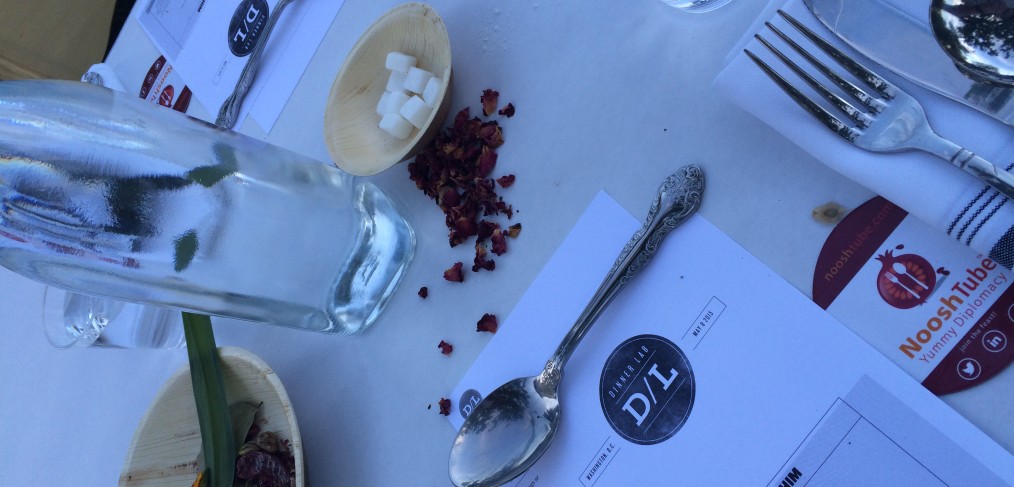
Dinner on the Silk Road: Oases in DC and Baltimore
The team at NooshTube knows that food is far more than its nutritional value – it is history, culture, adventure, etc. So, we sought a tangible and sensory platform through which we could bring this notion to fellow Nooshtubers and foodies. Our partners at Dinner Lab gave us an amazing opportunity to realize this goal in the creation of a culinary adventure to highlight the many dishes of the Silk Road. On May 8-9, we debuted our Silk Road menu to a host of delighted guests in Washington, DC and Baltimore.
We started our journey in Cappadocia, a region of present-day Turkey that housed many caravanserais for the eastward journey towards Xi’an. In the Kapadokya Koftas, I used a simple blend of sweet spices and fresh parsley for the minced meat, which was served with refreshing mint-yoghurt chutney found in the many alleys of Old Delhi.
For the next course on our menu, we traveled far to the high Pamir Mountains, often called the Roof of the World. This is where the Himalayas, Hindu Kush, Tian Shan, etc. all converge to spectacular sceneries, hosting some of the world’s most resilient cultures and vibrant culinary traditions. Along the slopes of these mountains, you will find wild forests of apples and apricots, as well as grape vines and onion shrubs. I captured some of these ingredients in the Pamiri Pilaf, which was served family-style to represent Silk Road hospitality.
From these high mountaintops, we took divergent routes for our next courses, journeying to the lush coasts of Arakan and the dry deserts of the Tarim Basin.
Pandan plants grow wild along many tropical beaches, but they are used as a cooking ingredient along the coasts of South and Southeast Asia. They impart a buttery aroma to a dish, reflected in nicknames like butter leaves or basmati leaves. As the tropics are not suitable for large-scale dairy production, these leaves serve as butter substitutes. The Arakan Egg dish also used coconut cream instead of heavy cream; the recipe for this particularly popular dish is provided below.
In the Tarim Basin, we cook up a very simple dish – Tarim Eggplant Tarka. It consists of eggplants, chickpeas, and onions. And I mean a lot of onions! The sweetness of the onions balances out the spices – mostly garam masala and turmeric – used in the dish. The dish is topped with a dollop of whipped yoghurt to add another layer of creaminess.
The last entrée of the night took us back west to Persepolis, where amongst its ancient ruins a dish was created to symbolize Iranian and Mesopotamian cuisines. Fesenjan is a favorite amongst many communities of this region, with its creamy combination of walnuts, pomegranate, and stewed chicken. Though usually a heavy dish, I created a lighter version for our event, all the while maintaining the essential flavor profiles of the pomegranates and walnuts. This dish was paired with Armenian pomegranate wine, complementing the sweet and sour notes of the sauce.
Lastly, our travels led us to a dessert that was truly emblematic of the Silk Road. Known as zulbiyeh or jalebi, amongst a host of other names depending on the culture and language, it is a crispy and airy fried batter, dipped in rose-flavored sugar syrup. The dessert was served with many rounds of Leila’s Rose Chai, a blend of black tea, rose petals, and cinnamon, and named after my beloved nani-jaan (grandmother).
However, the highlight of our events was the partnerships and friendships we created in the process. None of this would have been possible without our caravan of like-minded people. We would like to thank our partners and fellow caravan members in this endeavor: Dinner Lab for hosting us, Bazaar Spices for the organic and highest-quality spices, RumiSpice for their essential saffron, and of course, to the whole NooshTube team for their collaboration and encouragement! Most importantly, many thanks to our supporters and diners for making the events a success. Nooshe-jaan!
Arakan Eggs in Coconut Cream
10 servings
Ingredients:
10 eggs, hardboiled and peeled
1/2 teaspoon turmeric powder
1/2 teaspoon paprika
Vegetable oil
For Coconut Cream Sauce
5 pandan leaves*, tied into knots
1/4 teaspoon ground cardamom
1 whole cinnamon sticks
1/2 cup onion paste
2 Tablespoon garlic paste
2 Tablespoon ginger paste
1/2 Tablespoon turmeric powder
Salt to taste
1 (14 oz) can of coconut cream
1 Thai green chili pepper, slit lengthwise
Chopped cilantro for garnish
Vegetable oil
- After peeling eggs, score them lightly 2-3 times. Mix with the turmeric powder and paprika and let rest for 15 minutes.
- Panfry the eggs until lightly browned. Remove from the oil and set aside.
- In the same oil, make the coconut sauce by first adding the knotted pandan leaves. Cook until aromatic. Then add the cardamom powder and cinnamon sticks. Cook for 2-3 minutes, until spices release fragrance.
- Add the onion, garlic, ginger pastes. Mix well with the spiced oil and cook for 5 minutes until mixture starts picking up color.
- Add the turmeric powder and salt. Cook for 2-3 minutes.
- Slowly mix in the coconut cream. Cover and cook until it reduces, about 5 minutes.
- Add the fried eggs and chili pepper to the coconut cream sauce. Cover and cook for another five minutes.
- Garnish with cilantro.
* Pandan leaves are found frozen in many Asian supermarkets. If you cannot find Pandan leaves, substitute with 10 Indian Bay Leaves (Tejpatta) and ½ teaspoon butter.
 Abdul-Kadar (AK) Rahim is a marketer and product developer with a healthy obsession with all-things culinary. He is part of NooshTube’s creative team, collaborating on content and marketing. Though brought up on the East Coast, he has a tendency to roam around the world, collecting stories and recipes along the way.
Abdul-Kadar (AK) Rahim is a marketer and product developer with a healthy obsession with all-things culinary. He is part of NooshTube’s creative team, collaborating on content and marketing. Though brought up on the East Coast, he has a tendency to roam around the world, collecting stories and recipes along the way.
